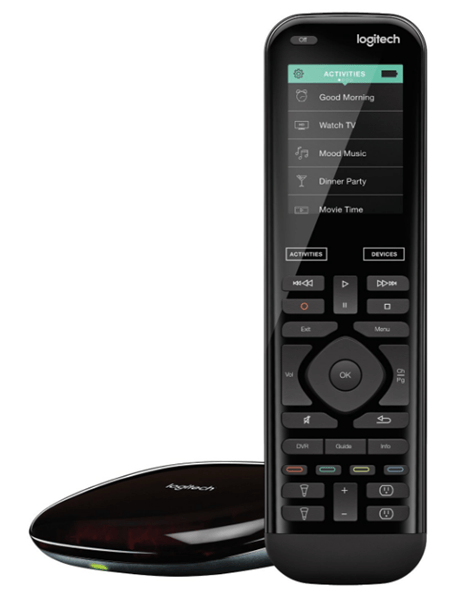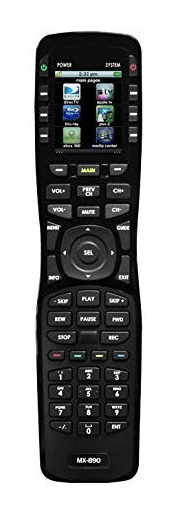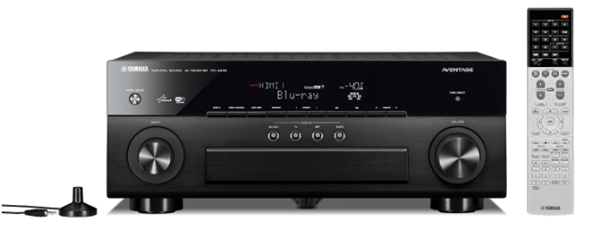IR & RF Home Theater
IR & RF Home Theater: a reader asks…

In this part of the universe, the trend is to have a closet built where the a/v and all encompassing electronic equipment resides. My stack is over 70′ away from my main entertainment center and is powered by a Yamaha advantage 840 and includes an array of ceiling mount speakers, 12″ power subwoofers etc. etc ad nauseam/or you get the point. How do I connect my firestick, fire tv blaster and echo to the closet stack. Im currently running mx890’s with an rf to ir converter in closet. I also have wireless ir blasters hooked up. I cant figure out the sequence. To make matters worse I have two complete different systems but both are the same as the aforementioned with the second one being for Master ensuite. Please help
I know that connecting home theater equipment can be a daunting task, but it sounds like you’ve conquered the majority of the issues, and have a sweet system (or two!). Connecting new pieces of equipment to your existing setup can be frustrating.

I am familiar with the Universal Remote MX890, but switched to a Logitech Harmony Elite system when I added new equipment to my system and discovered that there was no easy way to program the MX890 myself. Not saying you should do this, but you may need help getting the MX890 remote programmed for new equipment.
Or not, with the Firestick/Echo products, you can voice-control most of your equipment. The Echo and the Firestick remote can convert your voice commands to RF commands recognized by the Firestick. The MX890 remote and the Firestick Blaster can convert RF commands to IR commands recognized by your other equipment.
As a primer, there are two ways to communicate control signals from a remote to another device: RF (radio frequency) and IR (infrared). The latter is line-of-sight only, that’s why you needed the IR blasters – so the IR remotes that came with the Yamaha receiver and any other gear in your closet could receive IR signals from the home theater room. RF controls don’t need line-of-sight, so they will work as long as the RF signal is strong enough (usually fine for your 70’ needs).

The IR blasters repeat the IR signal from the theater room to the closet. Your MX890 remote uses RF to communicate with its IR-control system, so it doesn’t need the IR blasters to work. The MX890 also has IR emitter on it so you can turn the TV/projector on and off (which is in the theater room with the remote and not visible to the MX890’s IR-control system in the closet).

For the main system you describe, I’m assuming that the Yamaha Adventage RX-A840 (online manual here) already has an HDMI cable running from one of the HDMI OUT ports on the receiver in the closet to the TV or projector, as well as wires running from the receiver to each of the speakers.
So any source device (such as the Firestick) can be plugged into an available HDMI IN port on the Yamaha receiver which sends the video to the TV/projector and sound to the speakers – no special wiring needed. Just plug the Firestick into one of the HDMI IN ports (#7 on page 10 of the manual) and connect the microUSB cable from the Firestick to the included wall wart power supply (hint, use the wall wart, not a USB port on your receiver or any other gear).

The included Firestick remote uses RF, so you should be able to use it in the theater room without any problem. You might need to use the small HDMI cable extension (that came with the FireTV) so you can place the Firestick above the back of the receiver (RF signals are blocked by metal) and ensure good wireless reception.

The Fire TV Blaster (I think you mean this device) is needed only to convert Echo/Firestick RF commands into IR signals to control other devices that use IR. So you’d mount the Fire TV blaster in the closet so it can send IR signals to your receiver (for volume control, source switching, etc.). If you also wanted it to control the TV/projector, you’d need a 2nd Fire TV blaster in the theater room (but you have your MX890 for that, so likely not needed unless you want total voice control).
If you do want total voice control, then by all means, enable the URC skill in your Amazon Echo device. That way you can use the existing MX-890 control system with your Amazon Echo. I haven’t tried this, but it should let you issue general voice commands that correspond to at least some of the button pushes you’d use on your MX-890 remote.

Your last issue sounds like the real problem – you want to use one Firestick with two video/audio systems. My low-tech answer is that: since the Firestick is so cheap, why not just buy a 2nd one for the Master ensuite? It will come with its own remote (and the remotes are pre-programmed to work with the Firestick they came with). When setting up each Firestick, you can name them so you can know which one you’re controlling (in the smartphone app).
I should mention that your Yamaha Adventage RX-A840 has two separate HDMI OUT ports, so you could’ve used the same system to provide video/audio to both the theater room and the Master ensuite (provided you could run an HDMI cable from the closet to the Master ensuite’s TV).

One potential issue you might run into is HD Copyright Protection (HDCP). All your devices (Firestick, receiver, TV) have HDCP circuitry built-in, and that circuitry is designed to prevent piracy of protected content. This circuitry usually involves a ‘hand-shaking’ process where each piece of connected equipment validates itself with all the other pieces of connected equipment. Where the problem can occur is that the validation process usually only happens at the initial point in time where the equipment is connected. If you connect the Firestick to the receiver but don’t have the TV connected at that time and later connect it, the Firestick won’t see the TV and won’t run the hand-shaking process a 2nd time. The simplest way to avoid this problem is to first power on your receiver and TV, set the receiver to use the HDMI port you’ll use for the Firestick, and only then plug in the Firestick to the receiver. That way the Firestick ‘sees’ all your connected equipment and validates with them as it’s powered on.
This website runs on a patronage model. If you find my answers of value, please consider supporting me by sending any dollar amount via:
or by mailing a check/cash to PosiTek.net LLC 1934 Old Gallows Road, Suite 350, Tysons Corner VA 22182. I am not a non-profit, but your support helps me to continue delivering advice and consumer technology support to the public. Thanks!









I have a Yamaha RX-V375 AV receiver and a Panasonic TC-58LE64 tv. I’ve tried connecting a Firestick to the receiver but I don’t get sound from my surround sound speakers. I’ve used an hdmi connector from tv to receiver and also an optical cable but neither work.
Hi Linda, you should’ve had no problems connecting the Firestick to the receiver and playing video out to the connected TV and audio out the connected surround sound speakers. The only thing you might have needed to do was adjust the Firestick’s audio settings to match what the receiver needed. In the Firestick menu (assuming you could see that on the TV screen), go to the audio settings. The Dolby Automatic setting should work, but you may have to try one of the other settings. Try each setting and then go to a video on the Firestick and start playing it. One of the audio settings on the Firestick should work for you.
Running an optical cable from the TV back to the receiver simply adds another audio source (whatever’s playing on the TV). Since the Firestick is connected directly to the receiver that’s unnecessary. The optical cable would be needed if you had plugged the Firestick into the TV.
Your Yamaha receiver’s manual is online at https://usa.yamaha.com/files/download/other_assets/3/329073/RX-V375_om_UCRABGLFH_En.pdf and shows (on page 23) how to connect an HDMI video/audio “source” like a Firestick to one of the four available HDMI IN ports on the back of the receiver. You should have:
After everything’s connected and the source settings are correctly set, you can plug the Firestick into the HDMI port of the receiver. Don’t forget to plug the Firestick’s included power supply into the wall and the other end into the microUSB port on the side of the Firestick – it won’t work without that. And you need to use the wall outlet & power adapter for the Firestick, connecting that microUSB cable to a USB port on the receiver or TV most likely won’t work as those ports don’t provide enough power to run the Firestick.
I’m sorry I never replied to this. Thank you SO much for helping me. Your instructions were easy to follow and worked perfectly. You are a great asset to many people struggling with their electronics!
hello Chris. I have a large music collection on 2 external drives. My main PC is in my hideaway, my secondary PC is in the living room connected to the stereo system. By day from the hideaway I would like to be able to minimally adjust the stereo volume, and if possible also advanced songs. What is the easiest way to that? A: use music collection on main PC with Bluetooth receiver and send to living room stereo somehow. B: use music collection on secondary PC and use a RF remote somehow? I am not knowledgeable enough to know how all this clearly works and am looking for advice while considering overall ease of use/set up/affordability. Your input would be of great help and much appreciated. thank you. Cheers Al
Hi Al, if I were doing something like this, I’d be looking at controlling my music with my smartphone, not with a PC. That way I can be anywhere (hideaway or whatever) and manage the music playing.
I happen to use an iPhone and have already imported my entire music library into Apple Music/iTunes. The same would work with Amazon Music or Google Play Music (if you use an Android smartphone). I would then play and control the music with whatever app on my smartphone I want, and send the music to a Bluetooth receiver to play out on other speakers.
If your stereo system doesn’t already have Bluetooth connectivity, you can purchase a Bluetooth connector like this one from Logitech for $40 (https://www.logitech.com/en-us/products/speakers/bluetooth-audio-adapter.980-000910.html). That lets you send audio from the smartphone to the stereo system. You can control the volume, tracks playing, etc. from an app on the smartphone.
This is much easier than trying to remotely control a PC and a stereo system. Either way you’d still have to manually turn on the stereo system, select the correct input source and set the main stereo system volume control. Your smartphone’s volume control would then be able to reduce the music volume, or increase it up to the level the stereo system is set at.
If you’re determined to use the PC>stereo setup, then you’d need a way to remotely control the secondary PC so you can switch tracks or albums (I think this is what you mean by “advanced songs”?). You can use remote control apps like TeamViewer (https://www.teamviewer.com/en-us/products/teamviewer/) and use the main PC to control the secondary PC. I should warn you, this is much more work for you than the smartphone method.
I have the same issue as your main response. IE equipment in the closet. Yamaha advantage receiver. The only difference is that I am only using the receiver. No convertor box, no other manufacturers. I was told that Music Cast is adequate.
Your take Chris.
Hi Gene, thanks for your question. So this isn’t a Firestick question, but a question about Yamaha receivers and MusicCast? Your economy of words means I have to guess what you’re asking. So…
I’m going to guess that you have your receiver connected to both surround-sound speakers and a TV, and that you don’t have any video/audio sources physically connected to the receiver. Rather, your need is to ‘cast’ video/music from your mobile device to the receiver’s speakers and TV, right? Making your mobile device the ‘source’ for the receiver…
Assuming you have a way to turn on the TV, you could use MusicCast to then send the video/audio to the receiver (which would wake up the receiver if it isn’t already on). But there may be an even simpler solution if all you want is to cast your video or audio from your iPhone.
Also assuming you’re using an iPhone or iPad, you really don’ t need another app. Your Yamaha Adventage receiver will just show up as another place to where you can share your iPhone’s video/audio – using iOS mirroring, the casting controls in your video app or iOS audio controls. With Android, you’ll just pair your phone with the receiver, and use Bluetooth to cast. For me and my iPhone and Denon receiver:
When I want to play video from one of my iPhone apps (Disney+, Netflix, etc.), I first make sure the TV is turned on, and then on my iPhone I start the video and use the cast icon in the upper-right corner of the screen (square with an up caret at the bottom) to select my receiver. That sends the video to my receiver, which then plays the audio on the connected speakers and video on the connected TV. I can still use the iPhone to start and stop the video, etc.
When I want to play audio from one of my iPhone apps (Spotify, Apple Music, etc.), I start playing the music on my iPhone, open my iOS Control Center, tap the top-right corner of the audio control box, and select my receiver from the list of speakers & TVs shown. That turns on my receiver and my music starts playing out the surround-sound speakers. I still use the iPhone app to start, pause, select songs, etc.
In both cases I control the volume with my iPhone’s hardware volume buttons.
Of course I’m guessing here as to your intent. If your question is not as I guessed, please give me more complete details as to what you’re trying to accomplish.
Hi Chris,
Any suggestions for the best IR Blaster to use? My utility closet upstairs with Yamaha RX-V4A in there aprox 50′ from the living room behind probably 3 walls. Current setup is wired and the small ir unit on tv wired through the walls up to the utility closet. If you do not hit the small unit perfectly with the remote it does not work. Very frustrating. Am I understanding from this thread above that a Blaster is what I need? New tech out there, there might be something better. Thanks for any insight.
DM
HI David, thanks for your question. Skip down to the seventh paragraph for one possible cheap thing to try to improve your situation. Sorry, but this is a widespread problem and there just are too many unknown variables about your situation to provide a definitive answer. It’s more a “things you can try” type of situation. A savvy home theater expert would likely have to do an on-site inspection to give you a better answer.
Looking at the Yamaha RX-V4A ‘s online manual (https://download.yamaha.com/files/tcm:39-1335527) – page 13 shows the Yamaha IR field of vision as +/- 30 degrees for that IR sensor embedded in the front of the receiver. But the small IR blaster module which you attached to the front of your TV may have a much narrower field of vision. And that IR blaster module’s field of vision may be different for horizontal and vertical axes. Did you try rotating the module 90 degrees to see if that helps? Or, is the IR module a small LED round button partially sunk into a housing? If so that housing may be limiting the IR sensor’s field of vision and beveling the edges from that housing may widen the field of vision.
Plus, IR coming from your remote is normally pretty weak and only good for perhaps 3 meters of distance from the IR module on the TV (or less) – are you further away and does moving closer improve the control even with less-accurate aiming?
Since you didn’t tell me the brand/model of your IR extender kit, I could guess that the IR blaster that’s connected to your TV doesn’t have a power supply located in the TV room area, but connects through the long wire to a box in the utility closet. Also guessing you’ve made/used a long wire to get 50′ to the utility closet that wasn’t included in the IR repeater/extender kit. Maybe you’re using a kit similar to this one: https://www.amazon.com/Infrared-Repeater-Control-Devices-Extender/dp/B01N674PE9/. If my guesses are right, the IR extender/repeater base unit doesn’t have a good signal booster, e.g., wasn’t designed for a long cable run and you’ll always have signal reliability problems. If you did purchase a long-range wired IR repeater system, then this paragraph doesn’t apply.
I should say that just about everybody has complaints about how closely they have to aim their remotes to get them to work, and complain about how unreliable IR control is in general. Your Yamaha receiver doesn’t have a direct IR sensor jack on the back for a wired connection, so you’re dependent on the front IR sensor and a some kind of an extender/repeater system.
Electronics manufacturers have responded with lots of products, such as Logitech’s expensive Harmony Elite (https://www.logitech.com/en-us/products/harmony/harmony-elite.915-000256.html), or Sewell’s BlastIR (https://sewelldirect.com/products/blastir-wireless-pro-ir-repeater). These types of devices convert IR to RF at the viewing area to transmit the control signals over longer distances and through walls. There’s a separate receiver unit in the utility closet that converts the signal back to IR to control the components. Some still suffer from issues with IR at the viewing location, such as distance from remote to IR sensor, angle of remote to IR sensor (e.g., the field of vision of that IR sensor attached to the TV), and the possible presence of direct sunlight through windows in the viewing area (sunlight has strong IR which can interfere with your remote’s weak IR signal).
But I’m guessing your issue is primarily of the IR sensitivity and field of vision for that little IR sensor you stuck on the TV. Is it possible to replace that with a better one? For example, this product https://www.amazon.com/Cable-Matters-Infrared-Extender-Repeater/dp/B014EDRH3G/ uses USB to provide signal boosting at the viewing area location, has a 30 degree field of vision and a range sensitivity of up to 15′ (remote to IR sensor). You’d have to snip off the IR transmitter module and splice that wire pair into your existing 50′ wire run. I can’t of course guarantee this will work, but it is a relatively cheap thing to try.
I haven’t done a review of various IR repeater/extender devices out there. I do have a Harmony Elite, and the biggest problem which I found with that is that each components’ remote has custom function buttons that simply aren’t available or obvious to use on the Harmony remote. I have reverted back to using separate component remotes, perhaps out of laziness. I do remember years ago when Radio Shack was in business that they had a simple kit, two pyramid-shaped devices, both with power adapters. Place one by your TV and one in front of your components and the IR>RF>IR connection worked pretty reliability. Unfortunately, that product is no longer available. Universal Remote has another expensive IR extender (https://www.bestbuy.com/site/universal-remote-control-rf-to-ir-remote-system-black/8367554.p?skuId=8367554), but I’ve not been thrilled with their devices having used several different models.